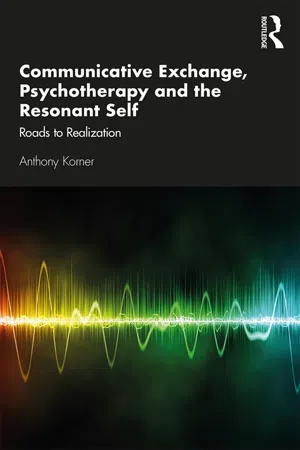
Communicative Exchange, Psychotherapy and the Resonant Self
Roads to Realization
- 216 pages
- English
- ePUB (mobile friendly)
- Available on iOS & Android
About this book
In Communicative Exchange, Psychotherapy and the Resonant Self, Anthony Korner demonstrates how important communication and resonance are to the development of a sense of self. This process of realization is embedded in social relatedness and is intrinsically tied to language.
Uniquely presenting a collaborative approach to research, this book illuminates the potential for change that lies in therapy that engages both heart and mind between patient and therapist, as well as demonstrating how language and relating are fundamental to psychotherapy. Korner explains how language engenders growth through communicative processes that shape lives and personality. Korner helps the reader see how communicative exchanges can be transformative. Brimmed with emotive clinical material, literary illustrations and reports of first-hand life experience, Korner demonstrates how the combination of knowledge and evocation of feeling in human connection is central to psychotherapeutic process.
An intersubjective approach to research is put forward as exemplar of how the minds of both patient and therapist might be employed in furthering understanding of psychotherapeutic process. This book will be an essential resource for mental health clinicians involved in psychodynamic psychotherapy, as well as more generally to people interested in understanding human connections.
Frequently asked questions
- Essential is ideal for learners and professionals who enjoy exploring a wide range of subjects. Access the Essential Library with 800,000+ trusted titles and best-sellers across business, personal growth, and the humanities. Includes unlimited reading time and Standard Read Aloud voice.
- Complete: Perfect for advanced learners and researchers needing full, unrestricted access. Unlock 1.4M+ books across hundreds of subjects, including academic and specialized titles. The Complete Plan also includes advanced features like Premium Read Aloud and Research Assistant.
Please note we cannot support devices running on iOS 13 and Android 7 or earlier. Learn more about using the app.
Information
Chapter 1
Cry and response
Overview
Communicative exchange
Resonant selves and resonant worlds
Being human
Cry and response
Table of contents
- Cover
- Half Title
- Title Page
- Copyright Page
- Contents
- Preface
- 1 Cry and response
- 2 Living language and the resonant self
- 3 Heart and soul: the feeling body
- 4 Making meaning together: the realization of value
- 5 Two minds greater than one: an intersubjective approach to research
- 6 Becoming who we are: personal realization
- 7 The long conversation
- References
- Index